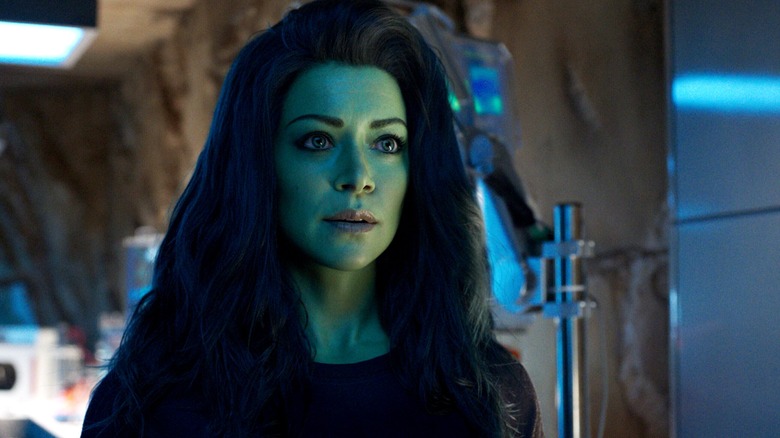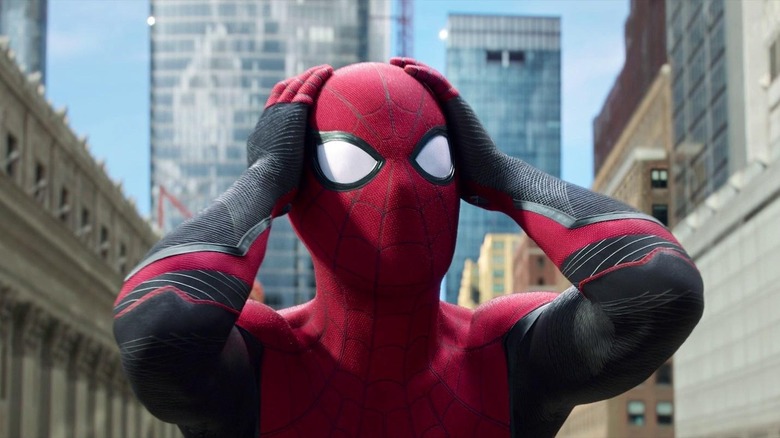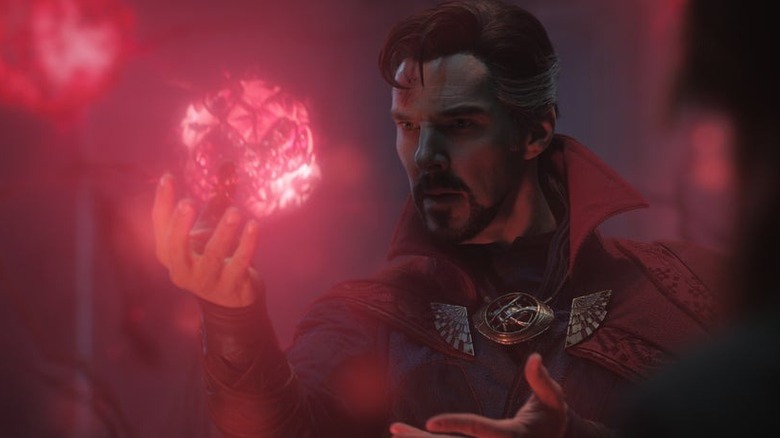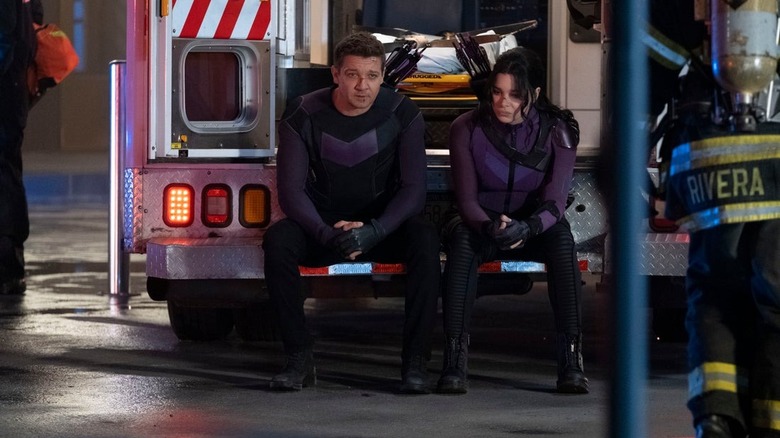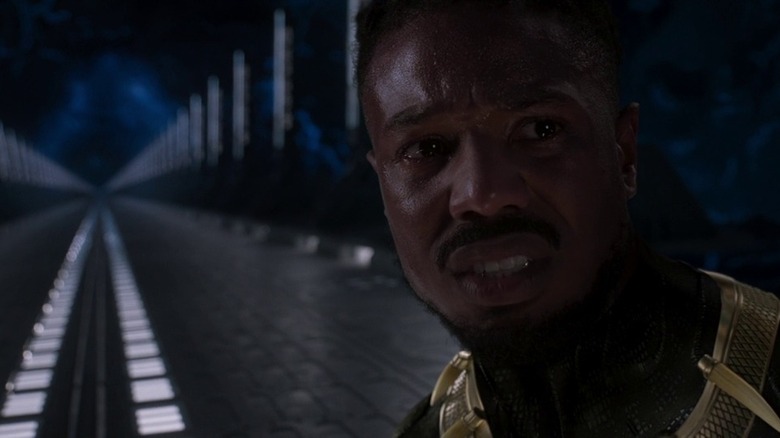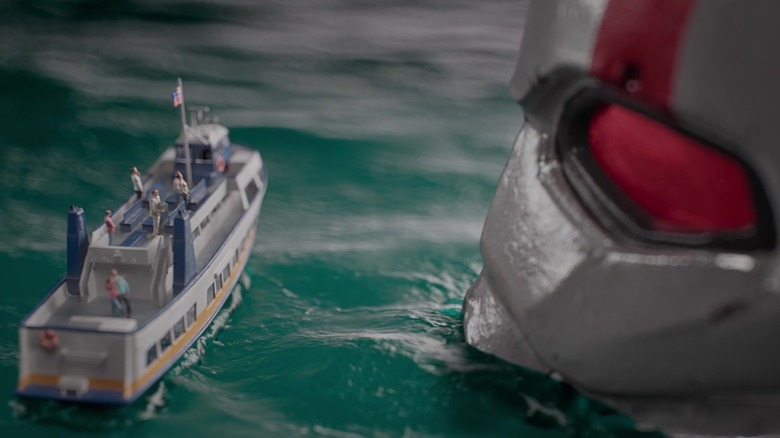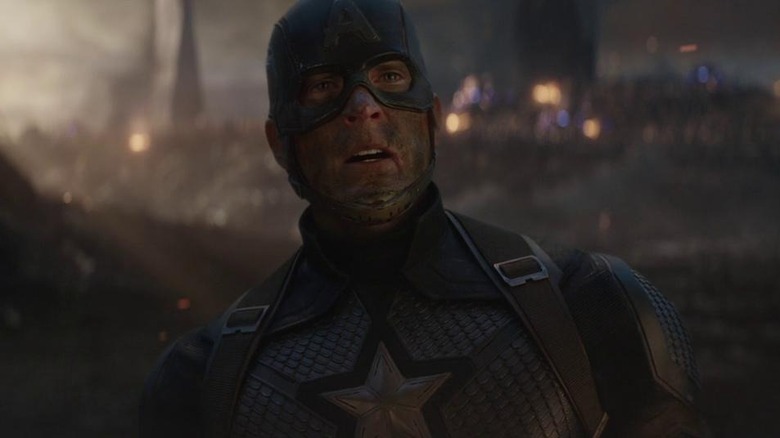How The Marvel Cinematic Universe Repeated The Original Sin Of Marvel Comics
In a recent interview, Variety asked Jessica Gao how much influence she had over the special effects animating the lead character of her new television series, "She-Hulk." Gao's answer was fascinating. "Marvel is this kind of machine," she said. "You can try to insert yourself as much as you can, but at a certain point, you're forced to get out of the way." Gao is an Emmy-award winning writer with experience in the animation industry. Yet Marvel Studios continues to enforce a rigid boundary between writers and directors like Gao, and the visual effects staff entrusted with creating the Marvel Cinematic Universe on screen.
Over the past several months, a flood of anonymous stories from visual effects artists have revealed deep institutional rot in the Marvel machine. A recent piece on Defector profiles overworked freelancers and compositors working long hours to clean up messes left by "name-brand talent" who are either too proud or inexperienced to do their jobs properly.
While it is tempting to blame individual bad actors, these cases are often systemic. Marvel Studios itself is responsible for underpaying and overworking the special effects teams it hires, resulting in poorly-planned films with barely functional effects. But this is nothing new for Marvel. After all, the studio's legacy was built as much on exploitation as genius.
The Marvel Method
Once upon a time, writer Stan Lee was seen as the creator of Marvel Comics. His frequent cameos in Marvel movies before his death in 2018 burnished his image as the eccentric but well-meaning grandfather of real-world superheroes. Yet Stan Lee was more of a producer than a writer. His true genius manifested in recognizing the talent of Jack Kirby, who became Marvel's signature artist, and Steve Ditko, who created the hugely popular "Spider-Man." Once Kirby and Ditko left Marvel to pursue their careers elsewhere, Lee gradually disintegrated from a man who captured the 1960s zeitgeist to a sellable name that scam artists fought for like dogs. (Further details of this sad story may be found in Abraham Josephine Reisman's "True Believer: The Rise and Fall of Stan Lee.") It could be argued that Kirby and Ditko's art, and not Lee's writing, represents the true legacy of Marvel Comics. But this doesn't quite do justice to the convoluted process by which Lee and his stable of artists told stories.
Lee initially "wrote" every comic under the Marvel umbrella while serving as editor. He did not have time to write comics traditionally. So his crew pioneered a technique that would be known as "plot script," or the "Marvel Method." The writer created a plot treatment that would cover the events of the issue. The artist would then draw the whole issue, deciding how many panels would be used on each page as well as the specific blocking of each scene. When the artist sent their work back to the writer, the writer would produce dialogue to fit the scenes they were given.
Unused pages
According to Sean Howe's "Marvel Comics: The Untold Story," Jack Kirby took full advantage of the freedom offered to him by this process. He introduced characters like the Silver Surfer, the herald of all-consuming entity Galactus, who never once appeared in Lee's original plot treatments. He blocked out each story with an artist's eye, rather than being constrained by Lee's explicit directions. Yet Lee's dialogue pass meant that he always had the final say on the events of a comic.
Early Marvel comics represent a battle of wills between creators that is either invigorating or nonsensical depending on the issue in question. Over the years, Kirby and Steve Ditko came to resent their own lack of control over the iconography they created. Ditko especially chafed at writing a character he didn't own, even as he took control of his run's final issues.
As Lee's plot write-ups became shorter and sparser, other artists at Marvel were frustrated by the lack of direction. Marvel paid them to be artists, not writers, yet the flexibility of the Marvel Method required them to do the majority of the work. Even company superstars like Kirby were not paid commensurately for what they contributed to each story. Worst of all, Lee would reject pages that did not meet his opaque standards. An article on Comic Book Resources featured an anecdote regarding "Mad" cartoonist Joe Orlando, who "would often have to draw 25-30 pages to get the 20 pages" for his Marvel work. "Marvel, of course, would not pay for those unused pages." The Marvel Method was designed to save Lee labor, but ultimately displaced that labor onto his artists.
The writer and artist must trust each other completely
Just like any other process, the Marvel Method has its success stories. Chris Claremont, whose run on "X-Men" transformed the series into one of Marvel's most popular books, found great success collaborating with artists like Alan Davis via the Method. Davis would say that while Claremont was always careful to provide him with whatever information he needed, "the looseness of the structure allows an artist to fully understand the story without being limited to a particular pacing or visualization." Years later, Matt Fraction and David Aja would produce their classic run on "Hawkeye" via an adjusted version of the Marvel Method. These partnerships led to happier results than the relationship between Lee, Kirby and Ditko. The difference is that for the Marvel Method to be successful, the writer and artist must trust each other completely.
Beneath the flesh of "She-Hulk" are the bones of the Marvel Method. On one side are the writers, actors and directors hired to break the story and take footage. On the other side are the hundreds of people responsible for processing and editing that footage, as well as the visual effects specialists charged with creating the world of Marvel. Finally, producers like Kevin Feige demand corrections and reshoots if the results fail to meet their expectations.
Movies are exponentially riskier and more expensive than comics. In order to ameliorate that risk, you might expect that Marvel Studios would involve visual effects specialists from the beginning of each project. By working closely with writers like Jennifer Gao, they might coordinate exactly how the story of "She-Hulk" could be best told with the time and resources available.
Pissing away $5 million
Unfortunately, this is not the way that Marvel films are made. In fact, Marvel Studios seemingly goes out of its way to hire directors and lead writers who lack experience making complex special effects driven blockbusters. When directors like Lucrecia Martel ask to supervise action scenes on their projects, they are ignored. Even directors like Ryan Coogler, who proved his action bona fides with "Creed," struggled with "Black Panther." The hand to hand combat sequences in the film are generally excellent. But company mismanagement resulted in a lackluster final battle, led by a special effects team that were assigned the scene at the very last minute and had to crunch to finish it by the deadline.
The contract between the Marvel Studios machine and their visual effects artists is very different from the one between Claremont and Davis, or Fraction and Aja. Rather than offer transparency, proper direction or commensurate pay, Marvel Studios bullies their artists into meeting the demands of a production under harsh time constraints and without sufficient creative direction. In the aforementioned Defector article, a technician (responsible for deleting unneeded shots from a film's video footage) tells a story of being given nearly a petabyte (1000 terabytes) of material to root through by Marvel Studios. "They might have had a $30 million budget for visual effects and pissed away $5 million of it," they said. Today's visual effects staff are expected to walk the same path as early Marvel's long-suffering artists, left to compensate for Stan Lee's mistakes.
The unsung heroes of comics
You may be asking yourself, "so what?" Marvel still has its pick of talented actors, directors and scriptwriters. The movies and television shows remain popular despite the recent negative press quoting anonymous sources. The company may easily ride out this controversy without taking a hit. But don't underestimate the technical staff that create the worlds of these movies. Compositors, layout artists, rigging artists and plates lab wranglers might never see their names on the poster. Yet all of them, and many more, are essential to fabricating the illusion of real-life superheroes. The thinner these workers are stretched, and the more of them break, the faster the Marvel Cinematic Universe collapses into its haphazard, terminally inefficient component parts.
Marvel Comics themselves are a team effort, rather than a simple collaboration between writer and artist. Legendary artist Neal Adams, whose work on "X-Men" and other series permanently raised the standard for superhero comics, benefited from Tom Palmer's fantastic inking. Walt Simonson's famous "Thor" run redefined the character, but so did John Workman's expressive lettering. Colorist Jordie Bellaire continues to elevate every book that she contributes to, proving that colorists are the unsung heroes of comics. A new comics reader might not know what inking, lettering, or coloring entail. But change any one of these elements, and that reader will notice, even if they can't put their finger on exactly what has changed.
Comics will break your heart
Marvel Studios needs to understand that the success of their films and television shows relies as much on their technical staff as it does their actors and directors. The best way to ensure their success leading into 2025 is to change their process. This could mean giving artists like Jessica Gao increased control over the production, allowing them to discuss their needs directly with the special effects team. It could mean training their directors in the skills they might need to manage these projects successfully. It will likely mean building productions around the needs of the technical staff, rather than demanding too late that they meet an impossible standard. The worst thing Marvel Studios can do, no matter how tempting it might be, is to continue to do things the same way as they always have.
If they fall to this temptation, they are doing worse than making a serious mistake. They are making the same mistake that their predecessors made decades ago, a mistake that hurt countless people just to save their bosses a little time. Jack Kirby is quoted as saying "comics will break your heart." There was no reason that the movies had to follow suit. But at this moment, despite or perhaps because of their great commercial success, that is precisely what is happening.
